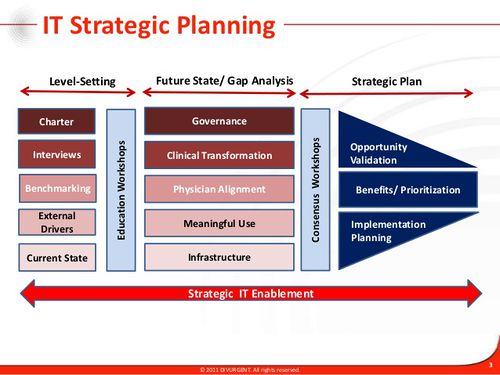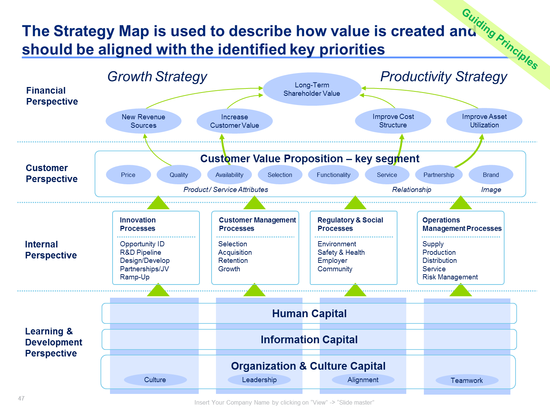Difference between revisions of "IT Strategic Plan (Information Technology Strategic Plan)"
| Line 11: | Line 11: | ||
An IT Strategic Plan follows a charter. | An IT Strategic Plan follows a charter. | ||
| − | [[File:IT-Strategic-Plan-Map.png| | + | [[File:IT-Strategic-Plan-Map.png|550px|IT Strategy Map]]<br /> |
source: Slidebooks Consulting | source: Slidebooks Consulting | ||
| − | == Essential Elements or Components of an IT Strategic Plan<ref>Anatomy of an IT Strategic Plan [https://www.cio.com/article/2437285/anatomy-of-an-it-strategic-plan.html | + | == Essential Elements or Components of an IT Strategic Plan<ref>Anatomy of an IT Strategic Plan [https://www.cio.com/article/2437285/anatomy-of-an-it-strategic-plan.html CIO Magazine]</ref> == |
To effectively support today’s IT-informed business strategies, CIOs must embrace new approaches to IT strategic planning that are more business-driven, flexible, and frequently revisited than in years past | To effectively support today’s IT-informed business strategies, CIOs must embrace new approaches to IT strategic planning that are more business-driven, flexible, and frequently revisited than in years past | ||
| − | *Start with [[Business Strategy | + | *Start with [[Business Strategy]]: IT strategic planning must be firmly rooted in the business strategic plan — period. If the business strategy is to invest in [[Digital Transformation (DX)|digital transformation]], for example, IT must extrapolate what that means for existing [[Enterprise Architecture|architecture]], [[IT Operations (Information Technology Operations)|operating processes]], skills, [[IT Sourcing (Information Technology Sourcing)|sourcing]], [[IT Governance|governance]], and [[Organizational Culture|culture]]. The best IT plan is no longer simply a rundown of the financial investment required or a list of technologies to implement. Rather, it is an assessment of the changes demanded to achieve business goals. The line between business strategy and technology strategy has disappeared, says ServiceNow’s CTO Chris Bedi. “They are one and the same.” Fenwick goes so far as to suggest there should be no IT strategy separate from the business strategy, preferring to call the IT-specific component an operating plan. |
| − | *Plan the | + | *Plan the Planning Process: At the outset, IT leaders should establish a plan to develop the plan. Gartner advises creating a “clear and achievable” process for developing the strategic plan, using any existing or previously used plan as a starting point. |
| − | *Strategize | + | *Strategize Wwiftly: While [[IT Strategic Planning]] is important, spending too much time to develop it can also be dangerous. Gartner advocates swift and focused strategic plan development in order to prevent loss of focus, scope creep, or diminished currency and relevance. |
| − | *Focus on the | + | *Focus on the Mid-term Horizon: Long-term [[IT Roadmap|roadmaps]] still have their place, but they have largely fallen out of favor, given today’s era of rapid technology and business shifts. While IT leaders must ensure that their choices are flexible enough adapt to longer-term technology change, the IT strategic plan should largely focus on the mid-term horizon, typically 12 to 18 months ahead. It can also address, in less granularity, plans in the two- to three-year range and five-plus years. Whatever time period IT leaders decide to cover, they should be sure to clarify the difference between the more tactical operating portion of the plan, mid-term strategy, and long-term goals. |
| − | *Nail the | + | *Nail the Key Components: An effective IT plan will include information on the people, staffing, partnerships, organizational changes, and governance required to achieve business outcomes. It can also include an investment portfolio roadmap, timeframes, goals, and a discussion of risks and other issues. |
| − | *Build in | + | *Build in Metrics for Success: The best IT strategic plans include measures of success that will serve as mile markers for progress over time. In today’s technology-driven marketplace, however, those [[IT Metrics (Information Technology Metrics)|metrics]] should focus less on the inputs or outputs IT may have used as guideposts in the past and more on actual business outcomes. Having clear, outcome-based[[Key Performance Indicator (KPI)|key performance indicators [KPIs]]] is essential. It is important to ensure tight integration with the business strategy. Those KPIs should be measured and reported at least monthly, although some should be tracked more frequently. Without defined measurable goals and measurement against them, a strategy can quickly become a pretty set of charts that get looked at once and filed away. |
| − | *Tie | + | *Tie Guiding Principles into the [[Business Vision|Corporate Vision]]: Many IT leaders will include a set of guiding principles or other explanations that guide IT’s decision making. Those guiding principles should tie into the overall corporate vision. |
| − | *Match | + | *Match Planning Frequency to the Cadence of the Business: Most IT organizations will create a full IT strategic plan at least once a year, but the fast-changing business environment demands that most update their approaches more frequently. The best rule of thumb is to adjust the frequency of IT planning to the cadence of the [[Business|business]]. For most companies, quarterly updates (at a minimum) will make the most sense. IT leaders in consumer-focused businesses, for example, will want to make changes more frequently. |
| − | [[File:It-strategic-planning-methodology-and-approach.jpg| | + | [[File:It-strategic-planning-methodology-and-approach.jpg|500px|IT Strategic Planning]]<br /> |
source: Divurgent (David Shiple) | source: Divurgent (David Shiple) | ||
Revision as of 21:03, 25 February 2020
Definition of an IT Strategic Plan[1]
An IT Strategic Plan (aka Information Technology Stategic Plan or ITSP) details the specific steps, with dates and deliverables, taken to implement the IT Strategy (information technology strategy) of an organization. These steps:
- Are necessary and sufficient to implement an IT Strategy
- They are prioritized
- They are divided into distinct phases
- They can be iterative and usually are
A Strategic Plan for IT must include the roles and responsibilities tasked with the implementation of each step in the plan. An IT Strategic Plan must also include relevant governance information.
An IT Strategic Plan follows a charter.
Essential Elements or Components of an IT Strategic Plan[2]
To effectively support today’s IT-informed business strategies, CIOs must embrace new approaches to IT strategic planning that are more business-driven, flexible, and frequently revisited than in years past
- Start with Business Strategy: IT strategic planning must be firmly rooted in the business strategic plan — period. If the business strategy is to invest in digital transformation, for example, IT must extrapolate what that means for existing architecture, operating processes, skills, sourcing, governance, and culture. The best IT plan is no longer simply a rundown of the financial investment required or a list of technologies to implement. Rather, it is an assessment of the changes demanded to achieve business goals. The line between business strategy and technology strategy has disappeared, says ServiceNow’s CTO Chris Bedi. “They are one and the same.” Fenwick goes so far as to suggest there should be no IT strategy separate from the business strategy, preferring to call the IT-specific component an operating plan.
- Plan the Planning Process: At the outset, IT leaders should establish a plan to develop the plan. Gartner advises creating a “clear and achievable” process for developing the strategic plan, using any existing or previously used plan as a starting point.
- Strategize Wwiftly: While IT Strategic Planning is important, spending too much time to develop it can also be dangerous. Gartner advocates swift and focused strategic plan development in order to prevent loss of focus, scope creep, or diminished currency and relevance.
- Focus on the Mid-term Horizon: Long-term roadmaps still have their place, but they have largely fallen out of favor, given today’s era of rapid technology and business shifts. While IT leaders must ensure that their choices are flexible enough adapt to longer-term technology change, the IT strategic plan should largely focus on the mid-term horizon, typically 12 to 18 months ahead. It can also address, in less granularity, plans in the two- to three-year range and five-plus years. Whatever time period IT leaders decide to cover, they should be sure to clarify the difference between the more tactical operating portion of the plan, mid-term strategy, and long-term goals.
- Nail the Key Components: An effective IT plan will include information on the people, staffing, partnerships, organizational changes, and governance required to achieve business outcomes. It can also include an investment portfolio roadmap, timeframes, goals, and a discussion of risks and other issues.
- Build in Metrics for Success: The best IT strategic plans include measures of success that will serve as mile markers for progress over time. In today’s technology-driven marketplace, however, those metrics should focus less on the inputs or outputs IT may have used as guideposts in the past and more on actual business outcomes. Having clear, outcome-basedkey performance indicators [KPIs] is essential. It is important to ensure tight integration with the business strategy. Those KPIs should be measured and reported at least monthly, although some should be tracked more frequently. Without defined measurable goals and measurement against them, a strategy can quickly become a pretty set of charts that get looked at once and filed away.
- Tie Guiding Principles into the Corporate Vision: Many IT leaders will include a set of guiding principles or other explanations that guide IT’s decision making. Those guiding principles should tie into the overall corporate vision.
- Match Planning Frequency to the Cadence of the Business: Most IT organizations will create a full IT strategic plan at least once a year, but the fast-changing business environment demands that most update their approaches more frequently. The best rule of thumb is to adjust the frequency of IT planning to the cadence of the business. For most companies, quarterly updates (at a minimum) will make the most sense. IT leaders in consumer-focused businesses, for example, will want to make changes more frequently.

source: Divurgent (David Shiple)
See Also
Business IT Alignment
Strategy
e-Strategy
Business Strategy
Corporate Strategy
IT Strategy Framework
IT Capability
Business Capability
IT Vision
IT Governance
Enterprise Architecture
Technology Roadmap
Information Technology Value
References
- ↑ What is an IT Strategic Plan (Information Technology Strategic Plan) CIO Index
- ↑ Anatomy of an IT Strategic Plan CIO Magazine
Further Reading
- IT Strategic Plan Template CIO Index

